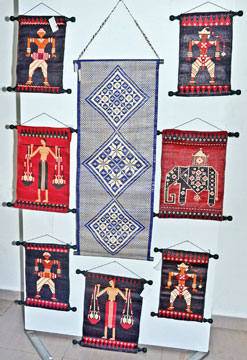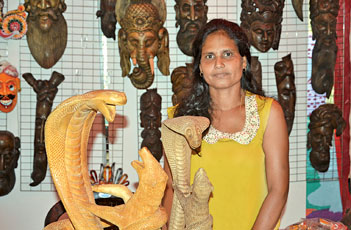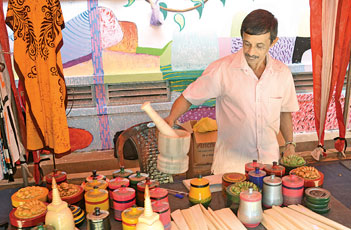|

Wall hangings
Pix: Vipula Amarasinghe |
Reviving a traditional crafts industry
Thunpath Rata - National Crafts Council exhibition:
By Sanjeevi Jayasuriya
Thunpath Rata, a traditional mat and woven products exhibition,
organized by the National Crafts Council, was held at the J.D.A. Perera
Art Gallery of the University of Visual and Performing Arts, Colombo
recently.
The exhibition was aimed at focusing on and improving the quality of
one of the traditional and valuable crafts of Sri Lanka. The weaving
industry has a history of over 3,000 years. While industrialization and
the influence of globalization has posed a threat to this industry it
has made a credible sustenance as a handicraft in Sri Lanka.
There is a gap between the potential markets and accessibility for
these products. The Thunpath Rata exhibition will help to bridge this
gap and educate society to be more social-conscious consumers, a
spokesman for the organizers said.
The University of Visual and Performing Art assisted this program
with a modern approach to uplift and re-introduce this traditional
craft. The council helps through research and guides craftsmen to make
the traditional mat using modern designs, he said.
Thumpath Rata mats and woven products exhibition 2016 displayed the
inherent skills of the artisans and the blending of a traditional craft
in the modern world. There were over 130 artisans and 31 designers
showcasing their products at the three-day exhibition. Business Observer
spoke to a few of the artisans at the venue.
Among them were R.P. Kusumawathie from Dodangaslanda, Kurunegala, who
produces thal kola baskets, flowers, fruit baskets, purses and different
types of bags. She is a Presidential Award winner and has been to India
four times.
"I display my products at the National Crafts Council and there is a
good demand for the products. I have 12 helpers to carry out my
venture," she said.
|

Dhammika Jayasinghe |
|

Jagath Wijeratne of Matale |
|

R.P. Kusumawathie from Dodangaslanda, Kurunegala, with her
assistant |
Jayanthi Gamage and H.H. Indra are from Weligama and Matara. They
produce Beeralu lace.
They said that the demand is somewhat low at present. Jagath
Wijeratne from Matale displayed different products made from Sapu and
Mahogany wood.
M.W. Fernando and Ramani Thenuwara have ventured into batiks.
Their factory, Ravimal Batiks, is in Marawila. They enjoy good demand
and are happy the way their business is flourishing. Dhammika and Jagath
Kumara Jayasinghe had a stall of statues of various kinds. They have a
showroom and a workshop in Athurugiriya.
Reed mats
Among the diverse handicrafts of Sri Lanka, the Pan Pedura or 'reed
mat', enjoys a paramount position. This utility mat is used by all
communities for domestic and ceremonial purposes. The weaving of mats is
not strictly confined to a particular area, while there are places where
it is done in commercial quantities due to the easy availability of raw
materials.
It is made out of a rush called Pan, grown in marshlands not suitable
for paddy cultivation.
There are several varieties of reed (Pan) such as Galleha, Thunhiriya,
Hambu and Heven which have different textures. The weaving is done
mainly by village women. The skill is preserved as it passes on from
mother to daughter.
In ancient Sri Lanka, every girl of marriageable age was expected to
know, how to weave a mat for her household use and not for commercial
purposes.
They were capable of weaving a colourful mat with intricate motifs
and designs. It is heartening to note that this craft is still preserved
in rural areas.
Plasticware
Today, some people prefer mats and other woven items made with
natural raw materials to the cheap plasticware that has infested the
country. They are even prepared to pay a higher price for a quality
handicraft product, but the problem is that they are unable to buy them
easily.
The village craftsmen find it difficult to sell their products and
they do not get a fair price for their labour. They are exploited by
middlemen. They also need guidance regarding designs and the changing
taste of the modern customer.
Thus, it is clear that there is a gap between the craftsmen and the
customer that has to be bridged.
If it is properly bridged it will help the craftsmen by strengthening
their economy. At the same time, it will provide the affluent customer
with a quality handicraft he is eager to buy.
The exhibition was held to achieve the social and market objectives,
through increase in demand; to educate the craftsmen as well as the
customer; and to popularize and preserve our ancient craft tradition.
The exhibition displayed mats depicting different motifs and pan
varieties, traditional implements related to pan, and various woven
utilities.
|

